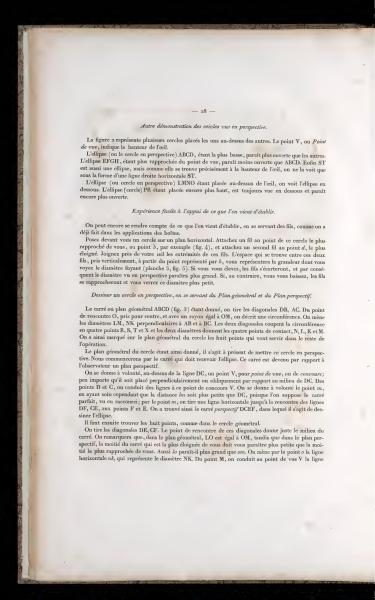Another Demonstration of Circles Seen in Perspective.
Figure 3 shows several circles placed one above the other. The point V, or Viewpoint, indicates the height of the eye. The ellipse (or circle in perspective) ABCD, being the lowest, appears more open than the others. The ellipse EFGH, being closer to the point of view, appears less open than ABCD. Finally, ST is also an ellipse, but as it is precisely at the height of the eye, it is only seen as a straight horizontal line ST. The ellipse (or circle in perspective) LMNO being placed below the eye, the ellipse is seen below. The ellipse (circle) PR placed even higher is always seen from below and appears even more open.
Simple Experiment to Support What Has Been Established.
You can further understand what has been established by using threads, as has already been done with box applications. Place a circle in front of you on a horizontal plane. Attach a string to the closest point of this circle to you, at a point ½, for example (fig. 4), and attach a second string to the point d, the farthest. Join the ends of these strings near your eye. The space between these two threads, taken vertically, from the point represented by f, will represent the size of the diameter as you see it (plate 3, fig. 5). If you raise yourself, the threads will spread apart, and consequently, the diameter seen in perspective will appear larger. Conversely, if you lower yourself, the threads will get closer, and you will see this diameter as smaller.
Drawing a Circle in Perspective, Using the Geometrical Plan and the Perspective Plan.
Given the square or geometrical plan ABCD (fig. 3), draw the diagonals DB, AC. From the intersection point OM, take this point as the center, and with a radius equal to OM, describe a circumference. Draw the diameters LM, NK perpendicular to AB and BC. The two diagonals intersect the circumference at four points R, S, T, and X, and the two diameters provide the four contact points, N, L, K, and M. Thus, marked on the geometric plan of the circle, the eight points that will be used for the remainder of the operation. The geometric plan of the circle being given in this manner, it is now a matter of placing this circle in perspective. We will start with the square that must receive the ellipse. This square has become, relative to the observer, a perspective plan. Place, as desired, above the line DC, a point Y, for viewpoint or concur; it does not matter whether it is placed perpendicularly or obliquely relative to the middle of DC. From points D and CI, lines are drawn to this point of convergence V. Point m is taken, ensuring that the distance lM is smaller than DC, as the square is supposed perfect, seen in foreshortening; from point m, draw a horizontal line until it meets the lines DF, CE, at points F and E. Thus, the perspective square DCEF is found, in which the ellipse must be drawn. Next, find the eight points, as in the geometrical circle. Draw the diagonals DE, CF. The intersection of these diagonals provides just the center of the square. Note that, in the geometrical plan, LO is equal to OM, while in the perspective plan, half of the square, which is the farthest from you, should appear smaller than the half closer to you. Hence, it seems larger than om. Draw through point a horizontal line nk, which represents the diameter NK. From point M, guide toward the viewpoint V the line
The text discusses the perspective view of circles placed at different heights relative to the observer's eye. It suggests a simple experiment using threads to demonstrate changes in perspective. Instructions are also provided for drawing a circle in perspective using a geometric and perspective plan. These instructions describe how to visually translate a geometrical circle into a perspective drawing.
